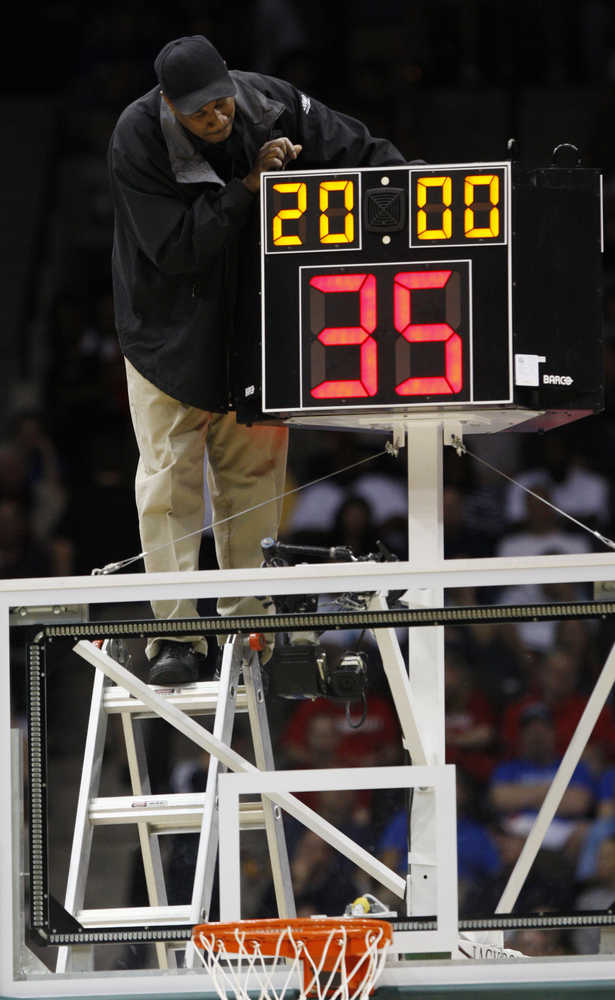MADISON, Wis. — Not all that long ago, Wisconsin grinded out games and won regularly by scoring in the 40s and 50s. Last year, Wisconsin could keep up with anybody with Frank Kaminsky and Sam Dekker leading the way.
The efficient Badgers are adept at adapting to the times and a new wrinkle has arrived this season: The shot clock has been shaved by five seconds, leaving teams — patient and otherwise — 30 seconds to run their offense.
Wisconsin’s Bo Ryan and other coaches aren’t necessarily buying that this will lead to dramatic changes in college basketball. But practices have changed subtly at many schools, communication and court awareness are more important than ever, and full-court pressure is getting a new look as a way to turn up the heat on offenses getting used to having less time on their hands.
“I’ve noticed it a little bit, having the clock five seconds less, especially with our scout squad putting pressure on us full court,” Wisconsin point guard Bronson Koenig said. “We just have to get things a little quicker.”
Teams with experienced guards like Koenig, and Wichita State’s Fred VanVleet and Ron Baker, may have easier adjustments. That veteran backcourt helped Wichita State finish fourth-best nationally in limiting turnovers last year.
“We’ll have to teach (new players) what it’s like to have to get a shot off at a certain point, whether that’s in a one-on-one situation, a ball screen, or whatever,” Shockers coach Gregg Marshall said. “When it comes to guys like (VanVleet and Baker), I’m not worried about it.”
At Arizona, Sean Miller is among many coaches making players more aware of “soft” full-court pressure situations, where an opponent might press or show press in an effort to slow an offense.
“When you do that, and you don’t understand the difference of five seconds, you start getting into a situation where it might have been 15 seconds left in the past but now it’s 10,” Miller said. “Or all of a sudden it’s five and it’s dire straits.”
Regardless, Miller continues to emphasize attacking with the ball and getting quickly in the offense.
“Obviously, on defense, we want to get them to the end of the clock. Maybe that will be to our advantage defensively,” Miller said.
Other teams were going back to work in practice, like Michigan after what coach John Beilein saw last week in an exhibition game against Le Moyne.
“There’s three seconds sometimes that it takes us to get into something, that we had the luxury to do before,” Beilein said. “We don’t have it. We’ve got to pop that ball and move and drive it.”
The shot clock was last changed before the 1993-94 season, when it went from 45 seconds to 35 seconds. It’s being changed again amid concerns over low scoring; Since 2012, teams have averaged around 68 points per game every year except 2014 — all near historic lows.
Like Michigan, North Carolina State used a 25-second clock in the preseason to prepare his team. Gottfried’s squad was also one of best in the country last year in limiting turnovers. The nonconference schedule in November and December will be a trial period, Gottfried said, but “people adjust a little bit, and I think everybody will be fine.”
At Syracuse, where coach Jim Boeheim’s 2-3 zone has frustrated teams for decades, there’s not much consternation.
“Most team shoot between 12 and 16 seconds, so I don’t think it’s going to have any effect at all,” Boeheim said. “I think if you went to 24, there would be a noticeable effect, but not 30.”
Over the summer, the Badgers played with an NBA-standard, 24-second clock for some pickup games. For practice possessions at half court, Wisconsin will start the clock at about 23 seconds now instead of 27. Working with a less experienced roster this season, Ryan started working on press defense and press-break situations on offense a little earlier than usual this preseason.
“You know, it’s still going to be you’ve got to put the ball in the basket and you’ve got to try to stop the other guys from putting the ball in the basket, whether it’s a 5-second shot clock or 30,” Ryan said.

